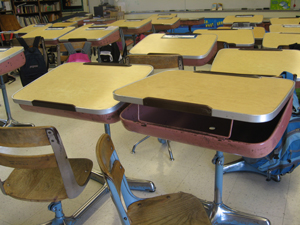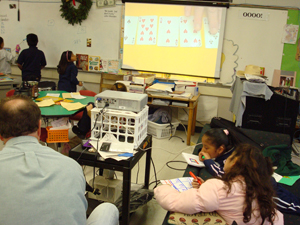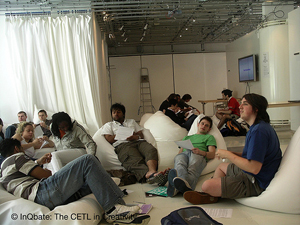![]()
 When I was in first grade, my classmates and I sat in small wooden desks that were arranged in five neat rows of six. I remember my teacher, Mrs. Sherwood, gently instructing me and the other six-year-olds to sit up with our backs straight and our hands folded primly on the desktop. Being a student who took authority seriously, I sat very still and remember being praised for sitting “the right way.”
When I was in first grade, my classmates and I sat in small wooden desks that were arranged in five neat rows of six. I remember my teacher, Mrs. Sherwood, gently instructing me and the other six-year-olds to sit up with our backs straight and our hands folded primly on the desktop. Being a student who took authority seriously, I sat very still and remember being praised for sitting “the right way.”
The truth is, even though teachers tend to want kids to sit in the classroom without moving around, it goes against the nature of the child. In fact, it goes against the nature of adults, too. Just like other living creatures, people are biologically programmed for physical activity throughout the day, not just at 10-minute intervals decided by others. Whether you work in a cubicle or a coffee shop, I can bet that you get up and move around within any given hour more than kids are allowed to.
When you think about how kids have an even stronger physical instinct to move around than adults do, and that they have a shorter attention span, it’s absurd that they’re often forbidden from doing so. Research shows that their bones are growing so quickly, particularly during puberty, that it’s physically unbearable to sit still for long periods of time. Hence, kids fidget.
An article in yesterday’s New York Times spotlighted a sixth-grade classroom in Minnesota that is experimenting with kid-friendly furniture. The teacher of the class, Abby Brown, noticed her students’ discomfort in regular desks and designed a solution.
On one recent morning, while 11-year-old Nick Raboin had his eye on his math problems, Ms. Brown was noticing that he preferred to shift his weight from one foot to the other as he figured out his fractions. She also knew that his classmate Roxy Cotter liked to stand more than sit. And Brett Leick is inclined to lean on a high stool and swing his right foot under a desk that is near chest level. Helps with concentration, he and Ms. Brown say.
The children in Ms. Brown’s class, and in some others at Marine Elementary School and additional schools nearby, are using a type of adjustable-height school desk, allowing pupils to stand while they work, that Ms. Brown designed with the help of a local ergonomic furniture company two years ago. The stand-up desk’s popularity with children and teachers spread by word of mouth from this small town to schools in Wisconsin, across the St. Croix River. Now orders for the desks are being filled for districts from North Carolina to California.
“Sometimes when I’m supertired, I sit,” Nick said. “But most of the time I like to stand.”
The stand-up desks come with swinging footrests, and with adjustable stools allowing children to switch between sitting and standing as their moods dictate.
“At least you can wiggle when you want to,” said Sarah Langer, 12.
With multiple classrooms filled with stand-up desks, Marine Elementary finds itself at the leading edge of an idea that experts say continues to gain momentum in education: that furniture should be considered as seriously as instruction, particularly given the rise in childhood obesity and the decline in physical education and recess.
 In the fall, I was lucky enough to spend time in the classroom of Tim Curley, a third-grade teacher at my old elementary school. Although the kids sit grouped around small tables to do written work, they spend at least as much time moving about the classroom (pictured here) — doing math games on the board, reading spelling words into the microphone, or sitting on the rug while they sing songs about science. Whenever I visit, every single student looks completely engaged. They know that they’re allowed to get up and wiggle or roam when they need to, so they don’t get stir-crazy like kids do when required to sit still.
In the fall, I was lucky enough to spend time in the classroom of Tim Curley, a third-grade teacher at my old elementary school. Although the kids sit grouped around small tables to do written work, they spend at least as much time moving about the classroom (pictured here) — doing math games on the board, reading spelling words into the microphone, or sitting on the rug while they sing songs about science. Whenever I visit, every single student looks completely engaged. They know that they’re allowed to get up and wiggle or roam when they need to, so they don’t get stir-crazy like kids do when required to sit still.
You probably remember sitting in hard desks yourself as a student. Wouldn’t you have preferred sitting on bouncy fitness balls, like some kids are able to use instead of regular chairs?
 If you have ideas for designing classrooms of the future, there’s a way for you to put them to use. The Open Architecture Network is hosting a challenge for anyone to partner with a school and help it address its challenges in providing “smart, safe and sustainable learning spaces.” You don’t have to be an architect to submit a design, and your school partner could win up to $50,000 for classroom construction, and $5,000 for you to help them do it. To enter, register by May 4, and submit by June 1.
If you have ideas for designing classrooms of the future, there’s a way for you to put them to use. The Open Architecture Network is hosting a challenge for anyone to partner with a school and help it address its challenges in providing “smart, safe and sustainable learning spaces.” You don’t have to be an architect to submit a design, and your school partner could win up to $50,000 for classroom construction, and $5,000 for you to help them do it. To enter, register by May 4, and submit by June 1.
The World Bank reports that countries worldwide will need to construct millions of classrooms by 2015, and millions more currently need to be updated. Here’s a great way to help “make the school fit the child, instead of making the child fit the school,” as my hero A.S. Neill said. It’s your chance to design the kind of classroom space that you wished you’d had, the kind that kids could actually have in the future.
Thanks to Darren Schwindaman for sending the New York Times article.
Your Two Cents: Leave a Comment!
What do you remember about sitting in the desks in your classrooms? If you could design a kid-friendly classroom, what are some of the elements it would have?
i wish i could sit on one of those desks right now. it’s 4:18 on a Friday afternoon. I.am.so.fidgety.
I love that the teacher had the nerve to actually think like a kid, and come up with something super-creative and functional as a result.
Janine, I want one of those desks, too! I’ve been sitting in the same spot for hours, and my back and neck are killing me. I’m going to curl up in a ball now.
Darren, I agree. When I sat in the kids’ desks myself, I thought, “If teachers would only sit here themselves, I think they would insist on much more comfortable furniture.”